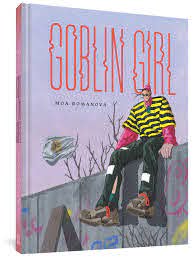NBCC members: If you’d like to contribute a review of an eligible book for the 2020 Leonard Prize, write to NBCC board member Megan Labrise at labrise@gmail.com. Read the rest of the reviews here.
Goblin Girl by Moa Romanova (Fantagraphics)
Graphic novels that garner mainstream acclaim tend to take on grand topics and make them accessible (often a touch sentimental), rendering serious issues in elegantly drawn miniature.
That’s not Moa Romanova’s Goblin Girl.
Pick up this debut Swedish autofiction, published stateside by Fantagraphics, because Romanova represents the next generation of cartoonists—those who don’t start from a position of proving the form. They grew up breathing bande dessinée, web comics, and manga, and bend their sequential art into unexpected sculptures with challenging shades-of-grey storylines (sometimes with a splash of neon).
Romanova’s caustic yet vulnerable quasi-memoir gave me that giddy feeling of discovery. With prickly humor and uncomfortable insouciance, she pokes at power-dynamics through a #MeToo moment that evolves into an inquiry about artistic purpose and authenticity. It’s a little bit Gaitskill, a little bit Girls, and certainly indebted to Phoebe Gloeckner—though, stylistically, the art is more like an ’80s Trapper Keeper cover mashup of Gary Panter and Michael DeForge. Solrad’s review calls her impressive approach “both improvisational and technical,” and Pop Matters, “an amalgam of slightly contradictory styles.”
As confirmed by a quick Instagram search, Romanova and her cadre are beautiful young women. She depicts herself and friends in a grotesque, ugly-cute distortion, blocky and bulging in a way that will smart with recognition for readers (let’s say, most women) who’ve experienced the acute dysmorphia of self-gaze. When Moa the character matches with a celebrity on a dating app, their encounter kicks off an episodic portrayal of her mental-health implosion, as the man offers to become a “patron” of her art while discontinuing their sexual relationship. Inevitably, things get weird(er). (One of the best moments is when her mom shows up as a Moomin). The art layers references, adding depth, but the writing’s also sharp—translator Melissa Browers deserves a shout-out here.
As we recognize emerging talent in discussing the Leonard prize longlist, I’m pleased to share this electric, disorienting graphic import deserving of a wider readership.


